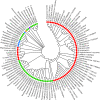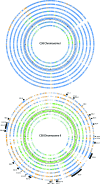Genome sequences of three agrobacterium biovars help elucidate the evolution of multichromosome genomes in bacteria
- PMID: 19251847
- PMCID: PMC2668409
- DOI: 10.1128/JB.01779-08
Genome sequences of three agrobacterium biovars help elucidate the evolution of multichromosome genomes in bacteria
Abstract
The family Rhizobiaceae contains plant-associated bacteria with critical roles in ecology and agriculture. Within this family, many Rhizobium and Sinorhizobium strains are nitrogen-fixing plant mutualists, while many strains designated as Agrobacterium are plant pathogens. These contrasting lifestyles are primarily dependent on the transmissible plasmids each strain harbors. Members of the Rhizobiaceae also have diverse genome architectures that include single chromosomes, multiple chromosomes, and plasmids of various sizes. Agrobacterium strains have been divided into three biovars, based on physiological and biochemical properties. The genome of a biovar I strain, A. tumefaciens C58, has been previously sequenced. In this study, the genomes of the biovar II strain A. radiobacter K84, a commercially available biological control strain that inhibits certain pathogenic agrobacteria, and the biovar III strain A. vitis S4, a narrow-host-range strain that infects grapes and invokes a hypersensitive response on nonhost plants, were fully sequenced and annotated. Comparison with other sequenced members of the Alphaproteobacteria provides new data on the evolution of multipartite bacterial genomes. Primary chromosomes show extensive conservation of both gene content and order. In contrast, secondary chromosomes share smaller percentages of genes, and conserved gene order is restricted to short blocks. We propose that secondary chromosomes originated from an ancestral plasmid to which genes have been transferred from a progenitor primary chromosome. Similar patterns are observed in select Beta- and Gammaproteobacteria species. Together, these results define the evolution of chromosome architecture and gene content among the Rhizobiaceae and support a generalized mechanism for second-chromosome formation among bacteria.
Figures





References
-
- Burr, T. J., C. Bazzi, S. Sule, and L. Otten. 1998. Crown gall of grape: biology of Agrobacterium vitis and the development of disease control strategies. Plant Dis. 821288-1297. - PubMed
-
- Burr, T. J., A. L. Bishop, B. H. Katz, L. M. Blanchard, and C. Bazzi. 1987. A root-specific decay of grapevine caused by Agrobacterium tumefaciens and A. radiobacter biovar 3. Phytopathology 771424-1427.
-
- Burr, T. J., and L. Otten. 1999. Crown gall of grape: biology and disease management. Annu. Rev. Phytopathol. 3753-80. - PubMed
-
- Cevallos, M. A., R. Cervantes-Rivera, and R. M. Gutierrez-Rios. 2008. The repABC plasmid family. Plasmid 6019-37. - PubMed
Publication types
MeSH terms
Substances
Associated data
- Actions
- Actions
- Actions
- Actions
- Actions
- Actions
- Actions
- Actions
- Actions
- Actions
- Actions
- Actions
Grants and funding
LinkOut - more resources
Full Text Sources
Other Literature Sources
Molecular Biology Databases

